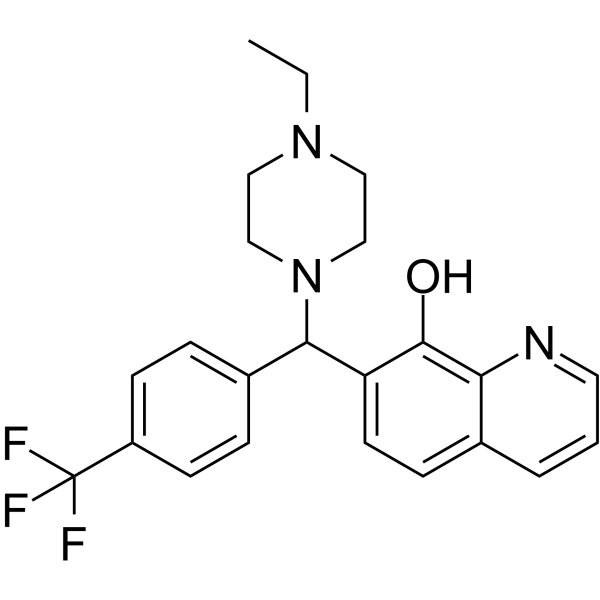Physicochemical Properties
| Molecular Formula | C23H24F3N3O |
| Molecular Weight | 415.451375961304 |
| Exact Mass | 415.19 |
| Elemental Analysis | C, 66.49; H, 5.82; F, 13.72; N, 10.11; O, 3.85 |
| CAS # | 315698-17-0 |
| PubChem CID | 3384730 |
| Appearance | White to off-white solid powder |
| LogP | 4.4 |
| Hydrogen Bond Donor Count | 1 |
| Hydrogen Bond Acceptor Count | 7 |
| Rotatable Bond Count | 4 |
| Heavy Atom Count | 30 |
| Complexity | 544 |
| Defined Atom Stereocenter Count | 0 |
| InChi Key | NGAPBLRRJSKIRT-UHFFFAOYSA-N |
| InChi Code | InChI=1S/C23H24F3N3O/c1-2-28-12-14-29(15-13-28)21(17-5-8-18(9-6-17)23(24,25)26)19-10-7-16-4-3-11-27-20(16)22(19)30/h3-11,21,30H,2,12-15H2,1H3 |
| Chemical Name | 7-[(4-Ethylpiperazin-1-yl)-[4-(trifluoromethyl)phenyl]methyl]quinolin-8-ol |
| Synonyms | ML311; ML-311; ML 311; EU-5346; EU 5346; EU5346. |
| HS Tariff Code | 2934.99.9001 |
| Storage |
Powder-20°C 3 years 4°C 2 years In solvent -80°C 6 months -20°C 1 month |
| Shipping Condition | Room temperature (This product is stable at ambient temperature for a few days during ordinary shipping and time spent in Customs) |
Biological Activity
| Targets | Mcl-1 Bim |
| ln Vitro | ML311 potently and with a usually high maximal effect (>80%) stops the viability of numerous types of Mcl-1 primed cells, such as MCL-1-1780 (EC50=0.31 μM), DHL-6 (EC50=3.3 μM), and NCI-H929 (EC50=1.6 μM). In a leukemia-derived cell line that is especially dependent on Bcl-2 function (Bcl2-1863, EC50=1.1 μM), ML311 also exhibits activity. With GI50<900 nM for nine cell types (RPMI-8226, SR, NCI-H322M, NCI-H60, HCC-2998, KM12, SF-295, U251, PC-3 cell lines) and <2 μM for fourteen more, ML311 has substantial growth inhibitory effects in a wide range of cell lines [1]. |
| References |
[1]. ML311: A Small Molecule that Potently and Selectively Disrupts the Protein-Protein Interaction of Mcl-1 and Bim: A Probe for Studying Lymphoid Tumorigenesis. Biotechnology Information (US); 2010-2012 Apr 16. |
Solubility Data
| Solubility (In Vitro) | DMSO : 67.5 mg/mL (162.47 mM) |
| Solubility (In Vivo) |
Solubility in Formulation 1: ≥ 2.25 mg/mL (5.42 mM) (saturation unknown) in 10% DMSO + 40% PEG300 + 5% Tween80 + 45% Saline (add these co-solvents sequentially from left to right, and one by one), clear solution. For example, if 1 mL of working solution is to be prepared, you can add 100 μL of 22.5 mg/mL clear DMSO stock solution to 400 μL PEG300 and mix evenly; then add 50 μL Tween-80 to the above solution and mix evenly; then add 450 μL normal saline to adjust the volume to 1 mL. Preparation of saline: Dissolve 0.9 g of sodium chloride in 100 mL ddH₂ O to obtain a clear solution. Solubility in Formulation 2: ≥ 2.25 mg/mL (5.42 mM) (saturation unknown) in 10% DMSO + 90% (20% SBE-β-CD in Saline) (add these co-solvents sequentially from left to right, and one by one), clear solution. For example, if 1 mL of working solution is to be prepared, you can add 100 μL of 22.5 mg/mL clear DMSO stock solution to 900 μL of 20% SBE-β-CD physiological saline solution and mix evenly. Preparation of 20% SBE-β-CD in Saline (4°C,1 week): Dissolve 2 g SBE-β-CD in 10 mL saline to obtain a clear solution. Solubility in Formulation 3: ≥ 2.25 mg/mL (5.42 mM) (saturation unknown) in 10% DMSO + 90% Corn Oil (add these co-solvents sequentially from left to right, and one by one), clear solution. For example, if 1 mL of working solution is to be prepared, you can add 100 μL of 22.5 mg/mL clear DMSO stock solution to 900 μL of corn oil and mix evenly. (Please use freshly prepared in vivo formulations for optimal results.) |
| Preparing Stock Solutions | 1 mg | 5 mg | 10 mg | |
| 1 mM | 2.4070 mL | 12.0351 mL | 24.0703 mL | |
| 5 mM | 0.4814 mL | 2.4070 mL | 4.8141 mL | |
| 10 mM | 0.2407 mL | 1.2035 mL | 2.4070 mL |
